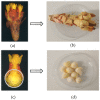Cytinus hypocistis (L.) L. subsp. macranthus Wettst.: Nutritional Characterization
- PMID: 30897825
- PMCID: PMC6471856
- DOI: 10.3390/molecules24061111
Cytinus hypocistis (L.) L. subsp. macranthus Wettst.: Nutritional Characterization
Abstract
The habit of eating wild plants in Europe is often associated with times of famine; an example of such is the nectar of Cytinus hypocistis (L.) L., a parasitic plant. To the authors' best knowledge, there are no studies on its nutritional and chemical composition; thus, the whole C. hypocistis (L.) L. subsp. macranthus Wettst. plant (CH) and its nectar (NCH) were nutritionally and chemically characterized. The proximate composition of CH and NCH were very similar in terms of energy, ash, and carbohydrate content. Protein and fat were approximately 2-fold higher in NCH, and crude fiber was 4.6-fold higher in CH compared to NCH. Fructose, glucose, sucrose, and trehalose were the free sugars present in both samples. Oxalic, malic, and citric acids were the identified organic acids in both samples, with citric acid as the most abundant molecule. For both samples, polyunsaturated and saturated fatty acids (PUFA and SFA, respectively) predominate over monounsaturated fatty acids (MUFA) due to the significant contribution of linoleic and palmitic acids, respectively. However, unsaturated fatty acids (UFA) prevail over SFA in CH and NCH. Therefore, CH proved to be an excellent source of nutritional compounds, which supports its use during past periods of scarcity.
Keywords: Cytinus hypocistis (L.) L. subsp. macranthus Wettst.; famine food; holoparasite; nectar; nutritional and chemical characterization; wild edible plant.
Conflict of interest statement
The authors state no conflict of interest.
Figures
References
-
- Torija-Isasa M.E., Matallana-González M.C. Mediterranean Wild Edible Plants. Springer; New York, NY, USA: 2016. A Historical Perspective of Wild Plant Foods in the Mediterranean Area; pp. 3–13.
-
- Łuczaj Ł., Pieroni A., Tardío J., Pardo-de-Santayana M., Sõukand R., Svanberg I., Kalle R. Wild food plant use in 21st century Europe: The disappearance of old traditions and the search for new cuisines involving wild edibles. Acta Soc. Bot. Pol. 2012;81:359–370. doi: 10.5586/asbp.2012.031. - DOI
-
- Carvalho A.M., Barata A.M. Wild Plants, Mushrooms and Nuts. John Wiley & Sons, Ltd.; Chichester, UK: 2016. The Consumption of Wild Edible Plants; pp. 159–198.
-
- Jman Redzic S. Wild Edible Plants and Their Traditional Use in the Human Nutrition in Bosnia-Herzegovina. Ecol. Food Nutr. 2006;45:189–232. doi: 10.1080/03670240600648963. - DOI
MeSH terms
Substances
LinkOut - more resources
Full Text Sources
Research Materials
Miscellaneous



